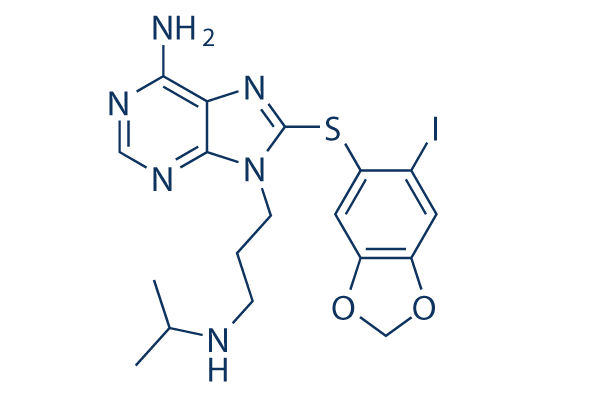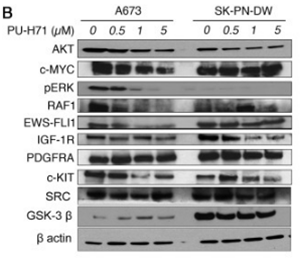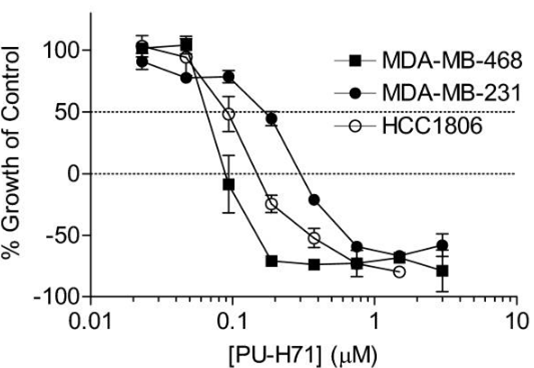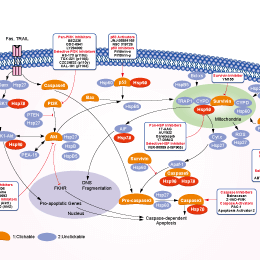
- Bioactive Compounds
- By Signaling Pathways
- PI3K/Akt/mTOR
- Epigenetics
- Methylation
- Immunology & Inflammation
- Protein Tyrosine Kinase
- Angiogenesis
- Apoptosis
- Autophagy
- ER stress & UPR
- JAK/STAT
- MAPK
- Cytoskeletal Signaling
- Cell Cycle
- TGF-beta/Smad
- DNA Damage/DNA Repair
- Compound Libraries
- Popular Compound Libraries
- Customize Library
- Clinical and FDA-approved Related
- Bioactive Compound Libraries
- Inhibitor Related
- Natural Product Related
- Metabolism Related
- Cell Death Related
- By Signaling Pathway
- By Disease
- Anti-infection and Antiviral Related
- Neuronal and Immunology Related
- Fragment and Covalent Related
- FDA-approved Drug Library
- FDA-approved & Passed Phase I Drug Library
- Preclinical/Clinical Compound Library
- Bioactive Compound Library-I
- Bioactive Compound Library-Ⅱ
- Kinase Inhibitor Library
- Express-Pick Library
- Natural Product Library
- Human Endogenous Metabolite Compound Library
- Alkaloid Compound LibraryNew
- Angiogenesis Related compound Library
- Anti-Aging Compound Library
- Anti-alzheimer Disease Compound Library
- Antibiotics compound Library
- Anti-cancer Compound Library
- Anti-cancer Compound Library-Ⅱ
- Anti-cancer Metabolism Compound Library
- Anti-Cardiovascular Disease Compound Library
- Anti-diabetic Compound Library
- Anti-infection Compound Library
- Antioxidant Compound Library
- Anti-parasitic Compound Library
- Antiviral Compound Library
- Apoptosis Compound Library
- Autophagy Compound Library
- Calcium Channel Blocker LibraryNew
- Cambridge Cancer Compound Library
- Carbohydrate Metabolism Compound LibraryNew
- Cell Cycle compound library
- CNS-Penetrant Compound Library
- Covalent Inhibitor Library
- Cytokine Inhibitor LibraryNew
- Cytoskeletal Signaling Pathway Compound Library
- DNA Damage/DNA Repair compound Library
- Drug-like Compound Library
- Endoplasmic Reticulum Stress Compound Library
- Epigenetics Compound Library
- Exosome Secretion Related Compound LibraryNew
- FDA-approved Anticancer Drug LibraryNew
- Ferroptosis Compound Library
- Flavonoid Compound Library
- Fragment Library
- Glutamine Metabolism Compound Library
- Glycolysis Compound Library
- GPCR Compound Library
- Gut Microbial Metabolite Library
- HIF-1 Signaling Pathway Compound Library
- Highly Selective Inhibitor Library
- Histone modification compound library
- HTS Library for Drug Discovery
- Human Hormone Related Compound LibraryNew
- Human Transcription Factor Compound LibraryNew
- Immunology/Inflammation Compound Library
- Inhibitor Library
- Ion Channel Ligand Library
- JAK/STAT compound library
- Lipid Metabolism Compound LibraryNew
- Macrocyclic Compound Library
- MAPK Inhibitor Library
- Medicine Food Homology Compound Library
- Metabolism Compound Library
- Methylation Compound Library
- Mouse Metabolite Compound LibraryNew
- Natural Organic Compound Library
- Neuronal Signaling Compound Library
- NF-κB Signaling Compound Library
- Nucleoside Analogue Library
- Obesity Compound Library
- Oxidative Stress Compound LibraryNew
- Plant Extract Library
- Phenotypic Screening Library
- PI3K/Akt Inhibitor Library
- Protease Inhibitor Library
- Protein-protein Interaction Inhibitor Library
- Pyroptosis Compound Library
- Small Molecule Immuno-Oncology Compound Library
- Mitochondria-Targeted Compound LibraryNew
- Stem Cell Differentiation Compound LibraryNew
- Stem Cell Signaling Compound Library
- Natural Phenol Compound LibraryNew
- Natural Terpenoid Compound LibraryNew
- TGF-beta/Smad compound library
- Traditional Chinese Medicine Library
- Tyrosine Kinase Inhibitor Library
- Ubiquitination Compound Library
-
Cherry Picking
You can personalize your library with chemicals from within Selleck's inventory. Build the right library for your research endeavors by choosing from compounds in all of our available libraries.
Please contact us at info@selleckchem.com to customize your library.
You could select:
- Antibodies
- Bioreagents
- qPCR
- 2x SYBR Green qPCR Master Mix
- 2x SYBR Green qPCR Master Mix(Low ROX)
- 2x SYBR Green qPCR Master Mix(High ROX)
- Protein Assay
- Protein A/G Magnetic Beads for IP
- Anti-Flag magnetic beads
- Anti-Flag Affinity Gel
- Anti-Myc magnetic beads
- Anti-HA magnetic beads
- Poly DYKDDDDK Tag Peptide lyophilized powder
- Protease Inhibitor Cocktail
- Protease Inhibitor Cocktail (EDTA-Free, 100X in DMSO)
- Phosphatase Inhibitor Cocktail (2 Tubes, 100X)
- Cell Biology
- Cell Counting Kit-8 (CCK-8)
- Animal Experiment
- Mouse Direct PCR Kit (For Genotyping)
- New Products
- Contact Us
research use only
Zelavespib (PU-H71) HSP (HSP90) inhibitor
Zelavespib (PU-H71, NSC 750424) is a potent and selective inhibitor of HSP90 with IC50 of 51 nM. Phase 1.

Chemical Structure
Molecular Weight: 512.37
Purity & Quality Control
Batch:
Purity:
99.03%
99.03
Related Products
| Related Targets | HSP40 HSP70 HSP90 HSP105 HSF1 | Click to Expand |
|---|---|---|
| Related Products | Tanespimycin (17-AAG) Luminespib (NVP-AUY922) Elesclomol (STA-4783) Ganetespib (STA-9090) Alvespimycin (17-DMAG) HCl VER155008 BIIB021 Onalespib (AT13387) NVP-BEP800 KRIBB11 SNX-2112 HA15 HSP990 (NVP-HSP990) NMS-E973 Apoptozole XL888 PF-04929113 (SNX-5422) KNK437 Teprenone TRC051384 | Click to Expand |
| Related Compound Libraries | Kinase Inhibitor Library Angiogenesis Related compound Library TGF-beta/Smad compound library Cytoskeletal Signaling Pathway Compound Library Anti-Cardiovascular Disease Compound Library | Click to Expand |
Signaling Pathway
Cell Culture and Working Concentration
| Cell Lines | Assay Type | Concentration | Incubation Time | Formulation | Activity Description | PMID |
|---|---|---|---|---|---|---|
| MDA-MB-468 cells | Function assay | Inhibitory activity against Hsp90 in human breast cancer MDA-MB-468 cell line, EC50=0.0102 μM | ||||
| SKBr3 cells | Growth inhibition assay | Growth inhibition in human breast cancer SKBr3 cell line using SRB, IC50=0.05 μM | ||||
| MCF7 cells | Function assay | 24 h | Inhibition of Hsp90 in human MCF7 cells assessed as Her2 level after 24 hrs by Western blot, IC50=0.06 μM | |||
| MRC5 cells | Cytotoxicity assay | Cytotoxicity against normal lung fibroblast MRC5 cell line, IC50=1 μM | ||||
| NCI-H1299 cells | Function assay | 12 h | Reduction in oxygen consumption rate in human NCI-H1299 cells incubated for 12 hrs | |||
| NCI-H69 cells | Function assay | 24 h | Binding affinity to HSP90 in human NCI-H69 cells after 24 hrs by fluorescence polarization assay | |||
| NCI-N417 cells | Function assay | 24 h | Binding affinity to HSP90 in human NCI-N417 cells after 24 hrs by fluorescence polarization assay | |||
| NCI-H187 cells | Function assay | 24 h | Binding affinity to HSP90 in human NCI-H187 cells after 24 hrs by fluorescence polarization assay | |||
| NCI-H510 cells | Function assay | 24 h | Binding affinity to HSP90 in human NCI-H510 cells after 24 hrs by fluorescence polarization assay | |||
| SKBR3 cells | Function assay | 24 h | Binding affinity to HSP90 in human SKBR3 cells after 24 hrs by fluorescence polarization assay | |||
| NCI-H526 cells | Function assay | 1 μM | 24 h | Binding affinity to HSP90 in human NCI-H526 cells at 1 uM after 24 hrs by fluorescence polarization assay | ||
| H69AR cells | Function assay | 96 h | Inhibition of HSP90-mediated antiapoptotic activity in human H69AR cells assessed as induction of cell growth arrest at 10 after 96 hrs by propidium iodide staining-based flow cytometry | |||
| NCI-H526 cells | Function assay | 24 h | Binding affinity to HSP90 in human NCI-H526 cells after 24 hrs by fluorescence polarization assay | |||
| Click to View More Cell Line Experimental Data | ||||||
Mechanism of Action
| Features | Purine-based, HSP90-selective inhibitor. | ||
|---|---|---|---|
| Targets |
|
In vitro |
||||
| In vitro | PU-H71 (1 μM) potently suppresses the growth of triple-negative breast cancers (TNBC) cell lines MDA-MB-468, MDA-MB-231, and HCC-1806 with IC50 of 65, 140 and 87 nM, respectively. PU-H71 (1 μM) kills 80%, 65%, and 80% of the initial population of MDA-MB-468, MDA-MB-231, and HCC-1806 cells, respectively. PU-H71 (0.25-1 μM) induces a dose-dependent degradation or inactivation of tumor driving molecules, including EGFR, IGF1R, HER3, c-Kit, Raf-1and Akt. Treatment for 24 h with 1 μM PU-H71, augments the percent of cells in G2-M phase of MDA-MB-468 to 69%, mediated by reduction in CDK1 and Chk1 expression. PU-H71 induces apoptosis in TNBC in part by inactivation and downregulation of Akt and Bcl-xL. PU-H71 leads to a proteasome-mediated reduction in IRAK-1 and TBK1 levels, resulting in approximately 84% and 90% reduction in NF-κB activity in MDA-MB-231 cells treated with 0.5 and 1μM PU-H71, respectively. PU-H71 markedly contains MDA-MB-231 cell invasion, with 90% suppression at 1 μM. [1] PU-H71 (2.5 μM) generates endoplasmic reticulum (ER) stress and activated the Unfolded Protein Response (UPR) as evidenced by XBP1 mRNA splicing (2.3-fold) and up-regulation of Grp94 (3.7-fold), Grp78 (4.9-fold), and CHOP (48-fold) protein expression and ATF4 (1.8-fold) mRNA expression. PU-H71 (1 μM) induces the mitochondrial pathway of apoptosis in HeLa cells, mediated by caspase but not calpain activation. In response to PU-H71-induced ER stress, apoptosis is triggered in melanoma, cervix, colon, liver and lung cancer cells, but not in normal human fibroblasts. PU-H71 is able to induce apoptosis overcoming the resistance conferred by Bcl-2. [2] PU-H71 (30 n M) significantly reduces NOS2 activity (60% reduction) and expression in LI (1 μg/mL LPS and 5 ng/mL IFN γ)-stimulated astrocytes via inhibiting NF-κB element activation. PU-H71 displays similar effects on microglial cells as on astrocytes, with 50 nM PU-H71 needed to significantly reduce the LPS dependent nitrite release. [3] | |||
|---|---|---|---|---|
| Kinase Assay | HSP90 binding assay | |||
| Measurements are performed in black 96-well microtiter plates. Cell lysates are prepared by rupturing cellular membranes by freezing at -70℃ and dissolving the cellular extract in HFB [20 mM Hepes (K), pH 7.3, 50 mM KCl, 5 mM MgCl2, 20 mM Na2MoO4, 0.01% Nonidet P-40] with added protease and phosphatase inhibitors. Saturation curves are recorded in which fluorescently labeled geldanamycin (Cy3B-GM) (3 nM) is treated with increasing amounts of cellular lysates. The amount of lysate that results in polarization (mP) readings corresponding to 90%-99% bound ligand is chosen for the competition study. Here, each 96-well plate contains 3 nM Cy3B-GM, cellular lysate (amounts as determined and normalized to total Hsp90 as determined by Western blot analysis using Hsp90 purified from HeLa cells as standard) and tested Hsp90 inhibitor in a final volume of 100 μL. The plate is left for 24 h on a shaker at 4 ℃, and the fluorescence polarization (FP) values in mP are recorded. EC50 values are determined as the competitor concentrations at which 50% of the Cy3B-GM is displaced. FP measurements are performed on an Analyst GT microplate reader. | ||||
| Cell Research | Cell lines | Human triple-negative breast cancers cell line MDA-MB-231 | ||
| Concentrations | ~5μM | |||
| Incubation Time | 3 days | |||
| Method | Exponentially growing MDA-MB-231 cells are seeded into black 96-well microtiter plates and incubated in medium containing either vehicle control (DMSO) or compounds for the indicated time at 37 ℃. Plates containing 3 replicate wells per assay condition are seeded at a density of 8×103 cells for each cell line in 100μL medium. After exposure of cells to the Hsp90 inhibitors, plates are equilibrated to room temperature (20-25 ℃) for approximately 30 min, and 100 μL CellTiter-Glo reagent are added to each well. Plates are mixed for 2 min on an orbital shaker and then incubated for 15 min to 2 h at room temperature. The luminescence signal in each well is measured in an Analyst GT microplate reader. |
|||
| Experimental Result Images | Methods | Biomarkers | Images | PMID |
| Western blot | AKT / c-Myc / pERK / RAF1 / EWS-FLI1 / IGF-1R / PDGFRA / c-KIT / SRC EGFR / HER3 / IGF-1R / c-Kit / Raf-1 / Akt / p90RSK / CSK / Hsp70 / Hsp90 Bcl-xl / p-PDK1 / p-AKT / cPARP LYN / SYK / BTK / AKT / MEK / ERK |

|
24388362 | |
| Growth inhibition assay | Cell viability |

|
19416831 | |
In Vivo |
||
| In vivo | PU-H71 administered at 75 mg/kg a.d. in the MDA-MB-231 model, induces a 100% complete response, and tumors are reduced to scar tissue after 37 days of treatment, accompanied with reduction in many proliferative and anti-apoptotic molecules, namely an 80%, 95%, 99%, 80%, and 65% decrease in EGFR, HER3, Raf-1, Akt, and p-Akt, respectively. PU-H71 (75 mg/kg, 3 times per week) induces a 96% inhibition of tumor growth, accompanied by an 60% reduction in tumor cell proliferation, an 85% decline in activated Akt associated with survival and high invasive potential, and a 6-fold increase in apoptosis. [1] | |
|---|---|---|
| Animal Research | Animal Models | Human triple-negative breast cancers xenografts MDA-MB-231 |
| Dosages | 75 mg/kg | |
| Administration | i.p. on an alternate day schedule | |
| NCT Number | Recruitment | Conditions | Sponsor/Collaborators | Start Date | Phases |
|---|---|---|---|---|---|
| NCT05612633 | Withdrawn | Accelerated Phase MPN|Blast Phase MPN |
Samus Therapeutics Inc. |
June 15 2022 | Phase 2 |
| NCT03935555 | Terminated | Primary Myelofibrosis (PMF)|Post-Polycythemia Vera Myelofibrosis (Post-PV MF)|Post-Essential Thrombocythemia Myelofibrosis (Post-ET MF) |
Samus Therapeutics Inc. |
August 12 2019 | Phase 1 |
| NCT03373877 | Terminated | Myelofibrosis|Primary Myelofibrosis|Post-polycythemia Vera Myelofibrosis|Post-essential Thrombocythemia Myelofibrosis |
Samus Therapeutics Inc. |
May 24 2018 | Phase 1 |
| NCT01393509 | Completed | Metastatic Solid Tumor|Lymphoma|Myeloproliferative Neoplasms (MPN) |
Memorial Sloan Kettering Cancer Center |
July 6 2011 | Phase 1 |
| NCT01581541 | Terminated | Solid Tumors|Lymphoma |
National Cancer Institute (NCI)|National Institutes of Health Clinical Center (CC) |
April 26 2011 | Phase 1 |
References |
|
Chemical Information
| Molecular Weight | 512.37 | Formula | C18 H21 I N6 O2 S |
| CAS No. | 873436-91-0 | SDF | -- |
| Synonyms | NSC 750424 | ||
| Smiles | CC(C)NCCCN1C2=NC=NC(=C2N=C1SC3=C(C=C4C(=C3)OCO4)I)N | ||
Storage and Stability
| Storage (From the date of receipt) | |||
|
In vitro |
DMSO : 100 mg/mL ( (195.17 mM) Moisture-absorbing DMSO reduces solubility. Please use fresh DMSO.) Ethanol : 100 mg/mL Water : 34 mg/mL |
Molecular Weight Calculator |
|
In vivo Add solvents to the product individually and in order. |
In vivo Formulation Calculator |
|||||
Preparing Stock Solutions
Molarity Calculator
In vivo Formulation Calculator (Clear solution)
Step 1: Enter information below (Recommended: An additional animal making an allowance for loss during the experiment)
mg/kg
g
μL
Step 2: Enter the in vivo formulation (This is only the calculator, not formulation. Please contact us first if there is no in vivo formulation at the solubility Section.)
% DMSO
%
% Tween 80
% ddH2O
%DMSO
%
Calculation results:
Working concentration: mg/ml;
Method for preparing DMSO master liquid: mg drug pre-dissolved in μL DMSO ( Master liquid concentration mg/mL, Please contact us first if the concentration exceeds the DMSO solubility of the batch of drug. )
Method for preparing in vivo formulation: Take μL DMSO master liquid, next addμL PEG300, mix and clarify, next addμL Tween 80, mix and clarify, next add μL ddH2O, mix and clarify.
Method for preparing in vivo formulation: Take μL DMSO master liquid, next add μL Corn oil, mix and clarify.
Note: 1. Please make sure the liquid is clear before adding the next solvent.
2. Be sure to add the solvent(s) in order. You must ensure that the solution obtained, in the previous addition, is a clear solution before proceeding to add the next solvent. Physical methods such
as vortex, ultrasound or hot water bath can be used to aid dissolving.
Tech Support
Answers to questions you may have can be found in the inhibitor handling instructions. Topics include how to prepare stock solutions, how to store inhibitors, and issues that need special attention for cell-based assays and animal experiments.
Tel: +1-832-582-8158 Ext:3
If you have any other enquiries, please leave a message.
* Indicates a Required Field






































